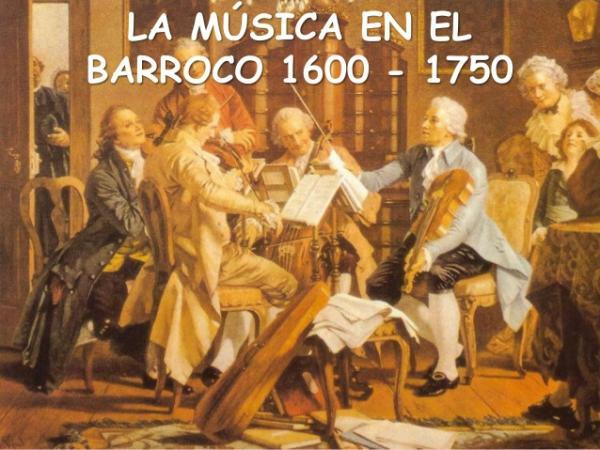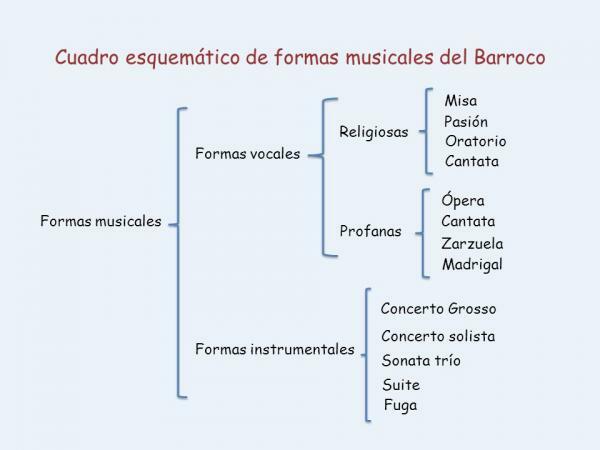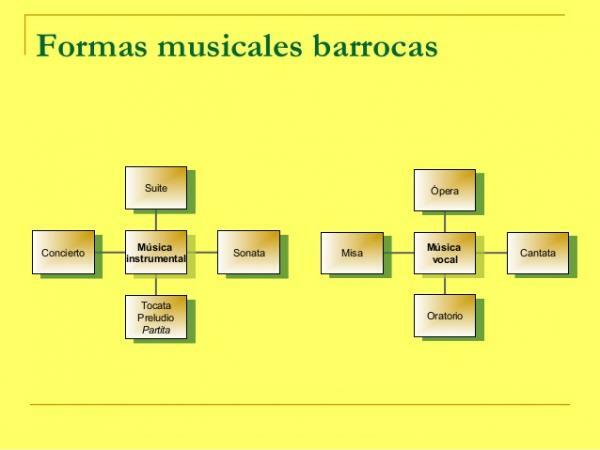The main musical FORMS of the BAROQUE

Image: Slideshare
It is inevitable to be influenced by our environment, both individually and in society. The context and the things that happen in the environment are shaping our way of thinking, doing things and therefore, in the production of our creations. Art, music, is not the exception to this, so we can observe how it has changed over time in its variations.
In this lesson from a TEACHER we will talk about Baroque musical forms and we will understand more about the different expressions in the works this time in the history of music.
Index
- What is the musical form
- Context and ideology of the Baroque
- Vocal forms, one of the main musical forms of the Baroque
- Instrumental forms of the Baroque
What is the musical form.
We will call you musical form to the set of elements that allow us to categorize a work thanks to the musical characteristics that we relate to trends and currents in history that come from the influence of the time.
The musical form is related to the genre and technical factors of
structure, speed and tempo, meter, harmony, instrumentation, motifs, etc.Context and ideology of the Baroque.
Before starting to talk about the musical forms of the Baroque, we must better understand this artistic and cultural movement. Baroque music takes place in the s. XVII, approximately in the years 1600-1750 and with more force in Italy, Germany, England, France and Spain.
It was a important time for music since the instrumental language developmentof the orchestra, mainly thanks to the popularity of the opera, which took place in theaters and was accompanied by groups of instruments. The baroque orchestra has rubbed strings as the predominant resource.
In the baroque, special appreciation is given to the workmanship, the extremes and the contrast. Unlike other times, the use of the concept of "tonality". There is continuous use of bass, clear and simple beat rhythms, simultaneous extreme voices, functional chord progressions, and spaces for improvisation and virtuosity.
Some of the notable musicians of this stage were: Johan Sebastian Bach, Georg Fredrich Händel, Georg Phillip Telemann, Domenico Scarlatti and Claudio Moteverdi.

Image: Slideshare
Vocal forms, one of the main musical forms of the Baroque.
We are going to talk about the main musical forms of the Baroque to better understand what kind of music and compositions took place at this time. We will differentiate it according to the vocal forms and the instrumental forms.
Opera
It was a highly popular theatrical genre. It has harmonized stage action, singing and instrumental accompaniment. It is based on a basic plot through and a story that follows a script with a wide dramatic sense. Within the opera the following interpretations were given: Recitatives, arias, instrumental numbers and choruses. Example: Orfeo by Claudio Monteverdi.
Oratory
Very similar to opera but with the following differences: main focus on choirs, no staging, usually in Italian. They generally had religious themes. Example: The Messiah by Georg Fredrich Händel.
Cantata
It is also a liturgical form, interspersed with instrumental symphonic performances with vowels. They had a general structure of recitative, aria, recitative, and aria. They were generally addressed to a select audience. Example: Cantata del Café by Johan Sebastian Bach.
Motet
A less popular form, almost obsolete during the time. They were religious compositions for several equal voices.

Image: Slideplayer
Instrumental forms of the Baroque.
Within the forms of the Baroque we also have to take into account those that are made using instruments. We differentiate the following:
Solistic forms
It refers to forms dedicated to being played by a single instrument, with a lot of ornamentation. Within this form we find the preludes, gigs, fantasies and fugues, which have spaces to show virtuosity and improvisation. The most popular works were written for keyboard instruments. The fugue in particular is a form that explores the counterpoint of voices and the development of motives. Example: Played and fugue in D minor, BWV 565, Johann Sebastian Bach.
Sonata
Composed for a soloist accompanied by one or two instruments with basso continuo. The usual formation consisted of violin, flute or oboe for soloist, plus cello and some instrument for chords such as the harp, organ, harpsichord or lute. It had a structure with usually 3 or 4 movements. Example: Bipartite Sonatas for harpsichord K. 1-555, Domenico Scarlatti.
Grosso Concert
It is a form written for 3 or 4 voices to be interpreted by a group of interpreters (around 15). It took place after the formation of the orchestra had been consolidated. Several of the instruments played a tune in unison (tutti) and also had a passage for a soloist (concertmaster). Example: Concerti Grosso Op.6, Georg Friedrich Händel.
suite room
The suite is a work composed of 4 movements or thoughts of dance:
- Allemande: Of German origin, measure in 4, moderate tempo.
- Cuorant: Slightly faster speed, ternary with hemiolias (combination of base rhythms 3 and 2).
- Sarabande: Slower piece, of Spanish origin, ternary.
- Jig: Of Irish origin, it is a faster dance.
Sometimes an overture or a piece was added at the end of the Giga, these could be:
- Minuet: Similar to the waltz, with a ternary measure.
- Rondo: Short piece alternating a main theme with other secondary ones (A, B, A, C, A, D, etc.).
Example: Concerti Grosso Op.6, Georg Friedrich Händel.
It is interesting to observe the individual characteristics of each period because we can have access to the panorama of the way of life and the ideas of the people who lived at this time. Art and in this case music, serve us as a window towards ideals and the perception of beauty at each stage of history.

Image: Slideshare
If you want to read more articles similar to Baroque musical forms, we recommend that you enter our category of Music history.



